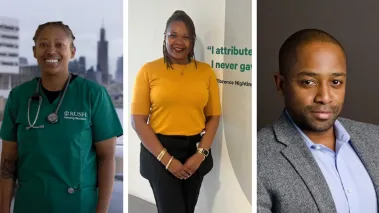Medical imaging is the use of different technologies to see within the body as a way to help diagnose, monitor and treat diseases and medical conditions.
You don’t need any special imaging equipment to see all of the opportunities an imaging sciences career will give you. A role as a medical imaging technologist may be for you if you have a knack for working with technology, and are passionate about patient care but may not have the desire to be a physician, nurse or another type of clinician.
Students interested in imaging sciences only need an associate or bachelor’s degree. A bachelor’s, though, gives you more opportunity for advancement and leadership roles in the field.
Imaging sciences students gain experience in the clinic as they advance through coursework focused on imaging technology, from X-rays and CT (computed tomography) to MRI (magnetic resonance imaging), to create images of the inside of the body. They also take courses in anatomy and the effects of diseases.
“There are so many skills involved in medical imaging,” says Laura Vasquez, PhD, director of the Imaging Sciences program at Rush University. “Some people think it’s just a person operating a machine and pushing of buttons. It’s not. The technology is much more complex, and it is becoming more customized. You have to know the scanner inside and out, while also utilizing excellent communication skills.”
Why choose a career in imaging sciences?
There is growing demand for imaging technologists, who enjoy a variety of career options and strong salaries without having to earn the advanced degrees required for many other fields in health care. Imaging technologists are among the highest ranked careers in U.S. News & World Report’s 2020 list of Best Healthcare Support Jobs.
“Imaging science really is a secret niche in health care,” Vasquez says. “I don't think many people realize how good the quality of life is. It’s a rewarding career and a great return on investment from your education.”
Jobs for imaging technologists are expected to grow 9% from 2018-28, according to the Bureau of Labor Statistics. That is faster than the average for all occupations. In May 2018, the median annual wage for MRI technologists was $71,670, while radiologic technologists were earning $59,520.
What is the most common form of medical imaging?
Some of the common forms of medical imaging are CT scans, MRIs, ultrasound and X-rays.
- X-rays measure ionizing radiation in the form of x-radiation as it passes through the body. X-rays are often used to check for bone fractures and dental decay, but they are also employed to identify lung infections and examine breast tissue for breast cancer through a mammography, among other uses.
- CT, or computed tomography, scans are created using computers and rotating X-rays. They create more detailed images of the body, which can help diagnose more complex bone fractures and detect different types of cancer.
- MRIs, or magnetic resonance imaging, use radio waves and magnets. This type of imaging is used to diagnose diseases associated with the brain, such as aneurysms, stroke and cancer.
- Ultrasounds use high-frequency sound waves to monitor a developing baby’s health, diagnose heart conditions and guide biopsies, among other uses.
What is the difference between imaging science and radiology?
Imaging science technologists perform medical imaging as instructed by a radiologist, who interprets the images and relays the findings to the physician who ordered the test. Radiologists are medical doctors, and there are three specialties in the field:
- Diagnostic radiology — diagnose patients using non-invasive medical imaging. They identify a variety of problems, including broken bones and heart conditions.
- Interventional radiology — not only diagnose but also treat patients using minimally invasive imaging equipment to guide surgical procedures.
- Radiation oncology — oversee radiation treatment plans for patients who have cancer.
What can you do with a degree in imaging sciences?
Most imaging technologists work in hospitals or other medical facilities, but they are also in demand for management and consulting positions for the companies that develop medical imaging technology. In addition, a bachelor’s degree in imaging sciences gives someone the credentials needed to teach students pursuing an associate degree.
Medical imaging technologists often specialize in MRI, X-ray or CT scans, as well as other areas in the field:
- Angiography — imaging of blood vessels and the heart
- Fluoroscopy — an X-ray test that examines the internal body and shows moving images on a screen
- Mobile radiography — using special scanners for patients who are too sick to travel
- Operating rooms — working in the OR to assist surgeons with special X-ray equipment during operations
- Trauma radiography — working in emergency rooms
Why study Imaging Sciences at Rush University?
At Rush’s Bachelor of Science in Imaging Sciences program, students learn from experienced practitioners who work with the most complex cases at one of the nation’s leading academic health centers, Rush University Medical Center. The program can be tailored to your knowledge level and schedule, and you’ll have important networking opportunities as you complete clinical rotations at health care organization in the Chicago area.
Rush’s imaging science students have a 100% pass rate on the American Registry of Radiologic Technologists (ARRT) national certification exam and a 98% average job placement rate. In addition, students give Rush a 4.8 on a 5.0 scale in program satisfaction surveys, and they receive a 4.6 on a 5.0 scale on employer satisfaction surveys.
“There are so many specialties,” Vasquez says. “It’s really hard to get bored. Our students are not only prepared to be competent diagnostic medical imaging technologists, but they are also ready to assume leadership roles in the profession by advancing evidence-based practice and understanding the value and benefits of interdisciplinary team-based care.”
Learn more about imaging sciences at Rush.







